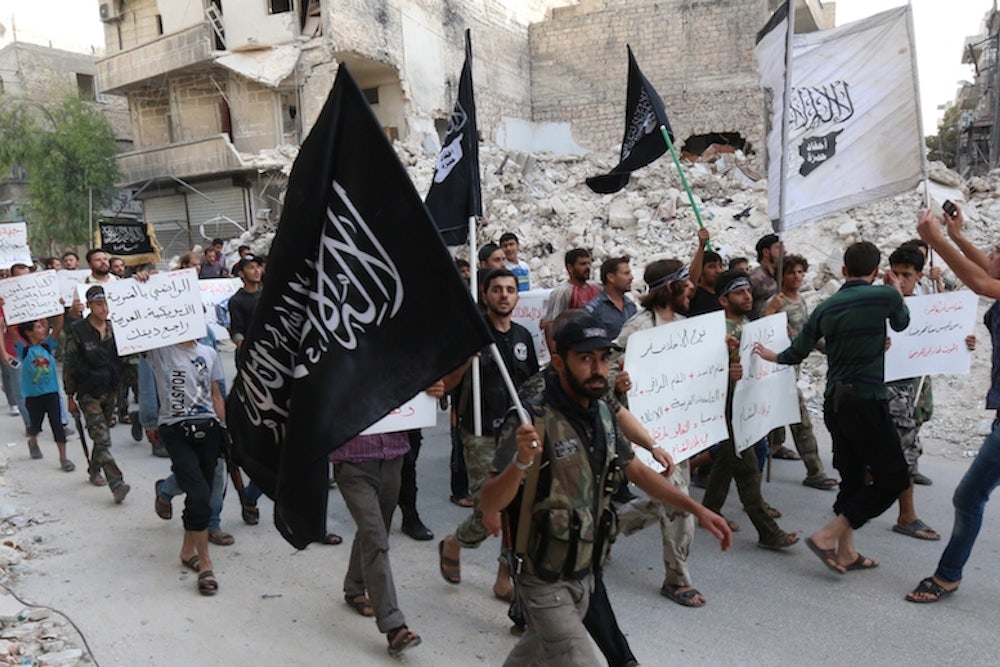Last week, the Associated Press reported that the Islamic State and Jabhat Al Nusra, an Al Qaeda affiliate in Syria, have reached an informal truce. The two rival groups agreed to stop fighting one another and focus their efforts against western-backed groups like the Syrian Revolutionary Front, the Hazm Movement, and Kurdish fighters in northern Syria. Increased cooperation between the country’s two largest jihadi groups highlights a strategic flaw in the U.S. military’s vague plan to train and equip moderate Syrian rebels to fight against the Islamic State. These moderate groups rose up to overthrow Bashar Al Assad—still seen by most Syrians as the country's greatest evil—and Pentagon support to fight the Islamic State seems like a betrayal of this primary purpose. The Islamic State, meanwhile, rose up not simply to overthrow Assad but to create an Islamic Caliphate across the Levant—and it will fight anyone opposed to its vision. The alliance between the Islamic State and Jabhat Al Nusra suggests these Islamist groups are taking advantage of the murkiness around the moderates' mission.
Jabhat Al Nusra and the Islamic State both trace their origins to Al Qaeda in Iraq. Al Qaeda central maintains ties to Jabhat Al Nusra but cut ties with the Islamic State in February. “Jabhat Al Nusra was focused on building a grassroots caliphate with popular support, whereas ISIS has taken the opposite approach—a top-down, centralized rule with a very heavy handed rule of its populace,” says Chris Kozak, a Syria analyst at the Institute for the Study of War.
For much of the past year, Jabhat Al Nusra and the Islamic State fought each other for territory, oil, and legitimacy in Syria. But as Al Qaeda’s central leadership saw would-be recruits pledging allegiance to the Islamic State (most recently, Egypt’s Ansar Beit Al Maqdis), they pushed the two groups to reconcile. According to Kozak, Al Qaeda sent some of its high level members to Syria (which make up the Khorasan group) to embed with Al Nusra and encourage them to hash out an agreement with the Islamic State. Neither group is willing to subordinate itself to the other—but they are united in their shared opposition to Syrian President Bashar al Assad as well as the anti-Assad groups that are backed by the West.
Although the U.S.’s official stance is “Assad needs to go,” the country lost credibility among many opposition fighters last year when it backed down from threats to bomb the Assad regime as punishment for using chemical weapons. The Free Syrian Army, which includes the Syrian Revolutionary Front and the Hazm Movement, views the Assad regime and the Islamic State as “twin terrorists” and has repeatedly expressed equal commitment to fighting both. But the Islamic State and Jabhat Al Nusra have capitalized on the opportunity to portray U.S.-backed groups as fighters who have abandoned the goal of toppling Assad.
In September, Jabhat Al Nusra leader Muhammad Al Jawlani warned that the U.S.-led coalition against the Islamic State “is seeking to put you back into the arms of Bashar.” He deplored “the traitorous factions that were bought by the West with some money and ammunitions so as to be a pawn in its hands on the inside to execute the new Crusader project.”
General John Allen, head of the anti-Islamic State coalition, fueled skepticism among Syrian opposition fighters when he told the Egyptian newspaper Asharq Al Aswat that the Syrian forces being trained by the U.S. to fight the Islamic State should not be the forces to take down the Assad regime. “Now, there could be FSA elements that ultimately clash with the regime, that may well be the case, as they seek to defend themselves,” he said. “But the intent is not to create a field force to liberate Damascus.”
“Expecting groups that have been fighting a regime which has committed horrible human rights abuses to shift its focus to a group that has been effectively fighting the regime—that’s asking a 180 degree shift in priorities,” says Kozak. He added that while the Islamic State and Jabhat Al Nusra offer their recruits weapons immediately, the U.S. military’s support is currently just a long-term promise. On Thursday, General Martin Dempsey told the House Armed Services Committee on Thursday to expect at least eight to 12 months before the effects of its train and equip program would have an on-the-ground impact.
Meanwhile, Jabhat Al Nusra has amassed popular support in places where it controls territory, largely because the group is seen as a legitimate threat to the Assad regime. When the U.S. expanded its bombing campaign from the Islamic State to include the Khorasan group (affiliated with Jabhat Al Nusra), anti-American protests erupted across Syria. A protestor from Aleppo told the Wall Street Journal, “Why strike Nusra? Nusra never directed their weapons against the people, but protected us against the regime.” He added that while he didn’t agree with Jabhat Al Nusra’s radical ideology, he feared that U.S. airstrikes would benefit the Assad regime at the expense of moderate Syrian fighters.
And so far, it has. U.S airstrikes against the Islamic State in Syria have afforded Assad greater resources to fight the moderate opposition. Since 2011, when what is now a bloody civil war was then a popular uprising, Assad defended his military’s crackdown as necessary to protect the country from terrorists. When given the choice to support a brutal dictator or a terrorist group, the international community will reliably throw its support behind the former. While that probably wasn’t the choice the world was faced with three years ago, it is looking increasingly likely as Assad continues to kill off the moderates who oppose him.
